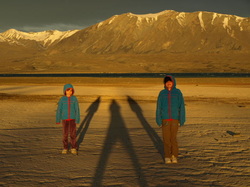
 Here's one of my favourite photos from the campervan trip. We'd set up camp at the edge of Lake Tekapo, east of the Mount Cook National Park. Dark clouds had moved in, blotting out the setting sun in the west. We were gearing up for rain in the night. Then, just above the horizon, the sun found a gap under the cloud sheet and suffused the landscape with an incredible warm light. The moment only lasted about 5 minutes before the Earth turned and the light was gone. Freda and Edie went crazy, running around the dried up lake bed (it's a reservoir) in a frenzy of pre-bedtime activity and delighting in their exaggerated shadows, but I managed to pin them both down for this shot. On the lake behind a rare Southern Crested Grebe was feeding.
4 Comments
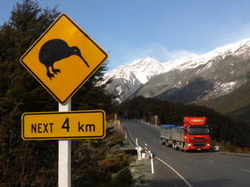 We never spotted a kiwi up at Arthur's Pass (where keas rule the roost), despite the sign. Finding the National Bird proved to be quite hard, although we heard them at night on a reserve on the east coast of Northland, and in the morning we discovered a hole in the grass which it was easy to believe could have been dug by a kiwi's long beak. Then again, maybe it was just an old tent peg hole. We did however see one in the kiwi-house at one of the Rotorua geysers - does that count for the tick? 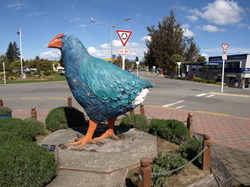 Yikes! What's that? There were no yellow signs on the road warning us about this big fellow in Te Anau. He's a takahe, a sort of local icon in the form of a large blue chicken. The takahe was thought to be extinct until 1948 when Geoffrey Orbell rediscovered a colony in the Murchison Mountains near Te Anau. Unfortunately, spotting a takahe (even in captivity) proved as elusive for us as stumbling across a Giant Moa or Haast Eagle. Those two really are extinct. Maybe. 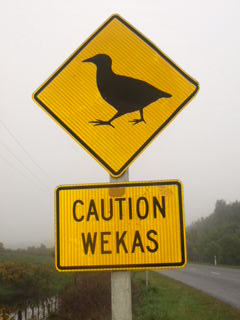 A weta is a large scary cricket. A weka (aka woodhen) is a dull brown, flightless bird like a small kiwi with a tail. Both are particularly annoying when they get caught up in your hair. We saw quite a few wekas near Cape Foulwind. This blustery place lived up to its name, providing rain as well as low cloud. The wekas proved to be an interesting diversion, counterbalancing the 'fowl' weather! 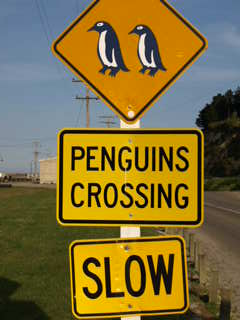 Yes, you really do have to slow down to avoid the Little Blue Penguins in Oamaru, north of Dunedin. Well, at night anyway, when they come ashore in rafts and waddle up the beach to their nest holes. We saw 256 of the comical little chaps. The Blue Penguin is not endemic to NZ - it's also found on the south coast of Australia, where it's known as the Fairy Penguin. These days however, the macho and politically-correct Australians prefer to avoid calling them "Fairies" and have switched to "Little Penguin". I'm not sure if the same fate has befallen the Fairy Tern. It would be a shame.
 Edie displays her poster. Edie and Freda finished their travel posters this morning and the last part of the project is to go to the Post Office and send them to the UK - one to Aberdeen and the other to the Black Isle. We leave for Syndey this afternoon. I've packed swimming toggs but the girls don't seem too keen to enter a pool; can't think why.
[see Freda's earlier entry]  Damage at the Beckenham shops still visible Today is exactly 2 months since the M7.1 earthquake hit Christchurch and since then there have been hundreds (if not 1000s?) of aftershocks, some strong enough to cause further structural damage and further fray the nerves of the already jittery population. Last night we were woken by a couple of rumblings (midnight and 7am), both about M4.1/M4.2 centred very close to the city (10km) and very shallow (1km). Earlier in the week a M4.5 rumbled through the whole house - it's timber/timber-framed so things tend to shake, rattle and roll a bit more than we're used to. The Hay kids are very nonchalant about these small earthquakes, despite witnessing the Big One in their own home. And Edie, used to the occasional house-wobbler in Yunnan, commented on Monday, "That was a funny earthquake Mum".
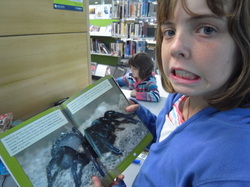 Freda reading about the Sydney funnelweb We are leaving for Australia this afternoon, to visit good friends of mum's in Sydney. So I went to the library to see what interesting things we might see while we'ere there. I found this book of deadly things and was terrified to find out that one of them even lives in Sydney. It's called the Sydney funnelweb spider. It drops from trees into people's garden swimming pools. It can survive underwater for up to 24 hours. They are quick to bite. Its venom causes a total short-circuit of a person's nervous system. Anti-venom is needed quickly! If this spider's bite is left untreated, it can be fatal within two hours! We are going to sydney and I definitely do NOT want to meet a funnelweb.
 Enjoying the space in Cashmere library. I was wiped out by a migraine yesterday so homeschool was cancelled. We're back on track today, however, with a project about our campervan travels. Homeschool was set up in Cashmere library [see photo], where we have free internet and large tables to work on. It's wonderful having so much space after 45 days in the van. It's easier to keep focused in a non-home environment. Well, that may be true were there not ducks in the pond outside the library window, and sparrows enjoying dust baths. Well, it's all good education!
See MORE VIDEOS for some recent movie clips from our travels. |
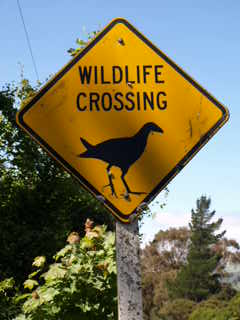
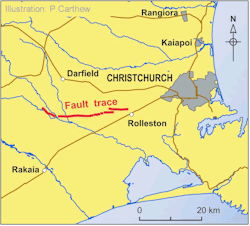
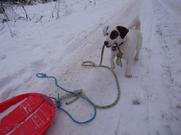
 RSS Feed
RSS Feed